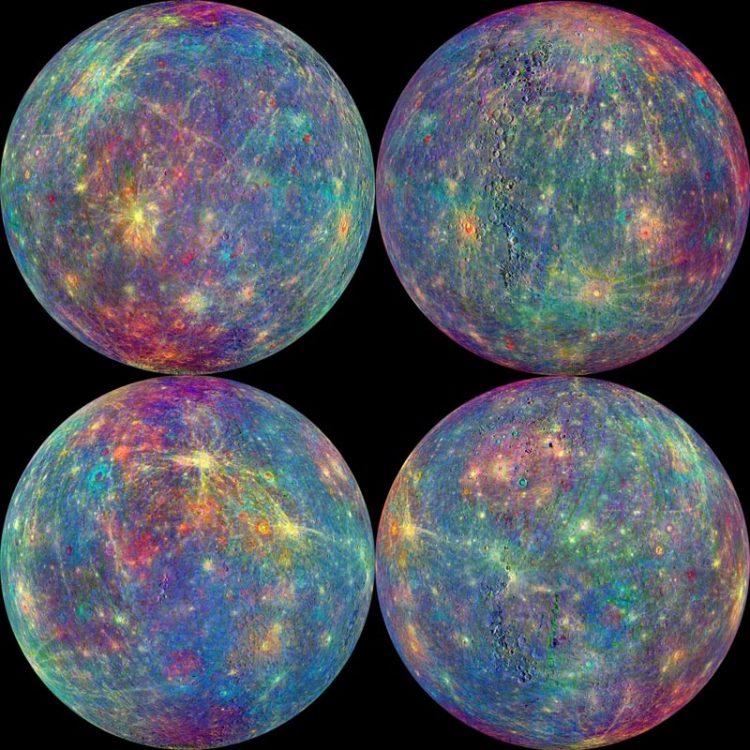Small collisions make big impact on Mercury's thin atmosphere

Scientists used models along with earlier findings from the MESSENGER mission to shed light on how certain types of comets influence the micrometeoroids that preferentially impact Mercury on the dawn side of the planet. Here, data from the Mercury Atmosphere and Surface Composition Spectrometer, or MASCS, instrument is overlain on the mosaic from the Mercury Dual Imaging System, or MDIS. Credit: NASA/Johns Hopkins University Applied Physics Laboratory/Carnegie Institution of Washington
Recent modeling along with previously published results from NASA's MESSENGER spacecraft — short for Mercury Surface, Space Environment, Geochemistry and Ranging, a mission that observed Mercury from 2011 to 2015 — has shed new light on how certain types of comets influence the lopsided bombardment of Mercury's surface by tiny dust particles called micrometeoroids. This study also gave new insight into how these micrometeoroid showers can shape Mercury's very thin atmosphere, called an exosphere.
The research, led by Petr Pokorný, Menelaos Sarantos and Diego Janches of NASA's Goddard Space Flight Center in Greenbelt, Maryland, simulated the variations in meteoroid impacts, revealing surprising patterns in the time of day impacts occur. These findings were reported in the Astrophysical Journal Letters on June 19, 2017.
“Observations by MESSENGER indicated that dust must predominantly arrive at Mercury from specific directions, so we set out to prove this with models,” Pokorný said. This is the first such simulation of meteoroid impacts on Mercury. “We simulated meteoroids in the solar system, particularly those originating from comets, and let them evolve over time.”
Earlier findings based on data from MESSENGER's Ultraviolet and Visible Spectrometer revealed the effect of meteoroid impacts on Mercury's surface throughout the planet's day. The presence of magnesium and calcium in the exosphere is higher at Mercury's dawn — indicating that meteoroid impacts are more frequent on whatever part of the planet is experiencing dawn at a given time.
This dawn-dusk asymmetry is created by a combination of Mercury's long day, in comparison to its year, and the fact that many meteroids in the solar system travel around the Sun in the direction opposite the planets. Because Mercury rotates so slowly — once every 58 Earth days, compared to a Mercury year, a complete trip around the Sun, lasting only 88 Earth days — the part of the planet at dawn spends a disproportionately long time in the path of one of the solar system's primary populations of micrometeoroids.
This population, called retrograde meteoroids, orbits the Sun in the direction opposite the planets and comprises pieces from disintegrated long-period comets. These retrograde meteroids are traveling against the flow of planetary traffic in our solar system, so their collisions with planets — Mercury, in this case — hit much harder than if they were traveling in the same direction.
These harder collisions helped the team further key in on the source of the micrometeoroids pummeling Mercury's surface. Meteroids that originally came from asteroids wouldn't be moving fast enough to create the observed impacts. Only meteoroids created from two certain types of comets — Jupiter-family and Halley-type — had the speed necessary to match the obseravations.
“The velocity of cometary meteoroids, like Halley-type, can exceed 224,000 miles per hour,” Pokorný said. “Meteoroids from asteroids only impact Mercury at a fraction of that speed.”
Jupiter-family comets, which are primarly influenced by our largest planet's gravity, have a relatively short orbit of less than 20 years. These comets are thought to be small pieces of objects originating in the Kuiper Belt, where Pluto orbits. The other contributor, Halley-type comets, have a longer orbit lasting upwards of 200 years. They come from the Oort Cloud, the most distant objects of our solar system — more than a thousand times farther from the Sun than Earth.
The orbital distributions of both types of comets make them ideal candidates to produce the tiny meteoroids that influence Mercury's exosphere.
Pokorný and his team hope that their initial findings will improve our understanding of the rate at which comet-based micrometeoroids impact Mercury, further improving the accuracy of models of Mercury and its exosphere.
Media Contact
All latest news from the category: Physics and Astronomy
This area deals with the fundamental laws and building blocks of nature and how they interact, the properties and the behavior of matter, and research into space and time and their structures.
innovations-report provides in-depth reports and articles on subjects such as astrophysics, laser technologies, nuclear, quantum, particle and solid-state physics, nanotechnologies, planetary research and findings (Mars, Venus) and developments related to the Hubble Telescope.
Newest articles

NASA: Mystery of life’s handedness deepens
The mystery of why life uses molecules with specific orientations has deepened with a NASA-funded discovery that RNA — a key molecule thought to have potentially held the instructions for…

What are the effects of historic lithium mining on water quality?
Study reveals low levels of common contaminants but high levels of other elements in waters associated with an abandoned lithium mine. Lithium ore and mining waste from a historic lithium…

Quantum-inspired design boosts efficiency of heat-to-electricity conversion
Rice engineers take unconventional route to improving thermophotovoltaic systems. Researchers at Rice University have found a new way to improve a key element of thermophotovoltaic (TPV) systems, which convert heat…



